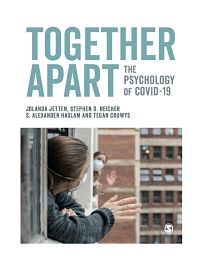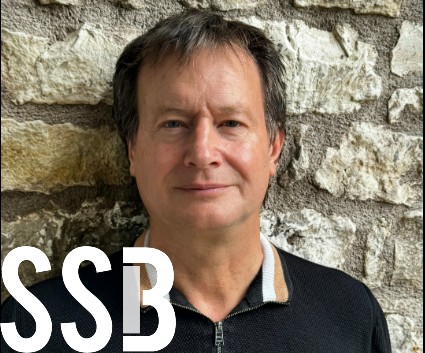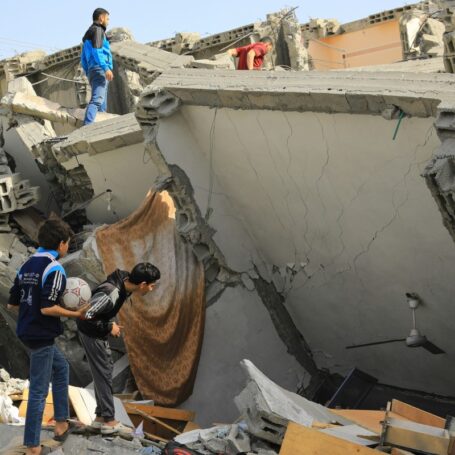Social Order and Disorder in Time of COVID: Excerpt from ‘Together Apart’
So far, the chapters in this section have concentrated primarily on the positive side of collective behaviour: solidarity with others in the community, and identification with and adherence to authority. A sense that ‘we are all in this together’ has led people in many countries to accept — even to embrace — a level of surveillance and restriction on personal freedom that might ordinarily lead to fury (see also Chapter 4). However, acceptance has not been universal. For example, in early April 2020 in Mumbai, migrant workers fought with police outside Bandra railway station during a protest against a COVID-19 lockdown (Kaonga, 2020). In Chile, conflict developed in protests against lockdown-induced food shortages for the poor (Fuentes, 2020). So when and why does such disorder arise, and how can governments and police forces act to prevent it?
Understanding disorder requires an understanding of collective history and culture
Our first point should be self-evident by now: disorder is not inevitable, even in hard times, or when people are deprived of the things which they normally take for granted (such as the right to go out for a walk). Nor is disorder a ‘natural’ consequence of collective psychology. What we see in this pandemic is what we always see: crowds are rarely violent. As we touched on in Chapter 12, when violence does occur, we need to look to the interaction between collective conceptions of rights and the nature of government interventions: where the former is seen to be trampled by the latter, trouble ensues.

Studies show that state interventions to control outbreaks of disease can violate collective conceptions of rights by being too harsh or poorly targeted (Harrison, 2020). They can also do so by being weak, tardy or just plain absent, in ways that indicate a lack of concern for whether people live or die. Indeed, a CIA analysis claims that the inability of some nations to provide adequate health care for their population has fuelled insurgencies against them (CIA, 2000).
Looking closer, the specific interventions that provoke conflict are those which display insensitivity to specific collective beliefs and cultural norms — often those surrounding death. In the 1890s, riots occurred in Egypt and Tashkent due to interference in Muslim burial rites (Sahadeo, 2005). During a cholera epidemic in Italy 1910, restrictions on traditional modes of burial sparked attacks on health-workers, police and hospitals (Snowden, 1995).
Looking closer still, another factor emerges. In these various cases, it was not simply that cherished customs were restricted, it was that state intervention was selectively applied. The poor were targeted while powerful elites found ways to circumvent restrictions. When conflict occurs, the issue of fairness is never far away. And if conflict occurs in a particular site (say around burial practices) it is generally because this can be harnessed to highlight a range of underlying inequities and grievances (see Chapter 2).
Taken together, the historical evidence suggests that social disorder arises through the relationship between social structural inequalities, collective beliefs and forms of state intervention. The lesson for today, as nation states struggle to curtail the spread of COVID-19, is that any intervention needs to be carefully planned in acknowledgment of underlying structural issues, so that these issues are attenuated rather than exacerbated. What then are the implications of this for what governments and police should actually do?
Effective policing requires dialogue, respect, trust and neutrality
The previous chapter introduced the concept of procedural justice as a central element in obedience to authority (Tyler, 2006). The central issue was whether people will listen to their authorities and responders. In this chapter, we are primarily interested in how people respond to the police. Here, procedural justice is, if anything, even more critical (Maguire et al., 2020) — especially the core proposition that people comply less through fear of punishment (‘instrumental compliance’) than because they are convinced that what they are being asked to do is the right thing to do (‘normative compliance’, Turner, 1991; see Chapter 4). In short, the most effective tool the police can have is legitimacy: the sense that they are doing the right thing for us.
Meares (2013) has translated this idea into four general rules that the police should observe in all their dealings with the public. The first is that in their encounters with police officers, people value having an opportunity to have ‘voice’ — that is, to put across their own view. The second is that people expect police officers to treat them with dignity and respect. The third principle is trust: people want the police todisplay benevolence and be well-intentioned. The fourth is that people value police neutrality: they want police officers to make their decisions based on the ‘facts’ of the situation rather than on the basis of prejudices or personal ‘biases’.
More concretely, during the COVID-19 pandemic the general principles of procedural justice and Meares’ four rules have been translated into the ‘Four ‘E’s’ guidance issued by the U.K. College of Policing to all U.K. local police forces (College of Policing, 2020). This advises police officers that their starting point should be to ‘Engage’ with the public. Then, rather than simply issuing instructions, they should ‘Explain’ what they want people to do and why. The next step is to ‘Encourage’ people to comply. Only if these dialogue-based approaches have been thoroughly tried and have failed should officers even consider turning to the more coercive fourth E: ‘Enforce’.
But on what basis should the police explain their actions and hence encourage (or ultimately enforce) compliance? The College of Policing document is explicit on this matter. It recommends that people are asked to observe restrictions in order to protect the National Health Service and save lives. In other words, the police are to explain that they are acting to protect the health of the public. In this way, policing takes us beyond Meares’ rules and the notion of procedural justice as simply about fairness in the abstract and the process of interaction. Rather, the key thing is to persuade the people that the police are serving the public interest (Reicher & Stott, 2020).
Taking this argument a step further, the important thing is that the effectiveness of the police depends upon being seen by the community as being of the community and acting for the community (Radburn & Stott, 2019), both in their style of interaction with the public and in the substantive content of what they do and say. It is this combination of being seen as both ‘of’ and ‘for’ a community that is critical. One cannot persuasively claim to be acting in the interests of the community while treating community members in a way that one would not treat ‘us’. Equally, one will gain little credibility by treating community members as ‘us’ if most of one’s actions go against community interests (Trinkner et al., 2018).
Ineffective policing ignores and exacerbates social inequalities
If policing by consent derives from the police being seen as ‘of us and for us’, the corollary is that dissent arises when the police are seen as ‘not of us and against us’. The potential for this is ever-present in deeply divided societies, especially given that the pandemic, far from being a great leveller, exacerbates those divides (see Chapters 17 and 18). As has been stressed throughout this book, lockdown is a very different experience for those whose lives are more or less precarious. The same restrictions on going out have very unequal impact on people who live in crowded flats or spacious houses with gardens. Whether or not the police treat you with respect and with understanding of your situation when outdoors can make all the difference in terms of whether or not the incipient divide comes out into the open.
As Tyler has argued, every encounter between a police officer and a member of the public is a teachable moment in which whole communities “learn about the law and legal authorities” (Tyler, 2012, p. 12). But this moment is not divorced from the wider experience of these communities. If it aligns with the sense that ‘we are all in this together’ then it can contribute to the preservation of order. If, however, it aligns with the sense that ‘my group gets a raw deal’ then it can be the beginnings of social disorder. In short, whether at the theoretical level or at the level of the participants’ experience, it is critical to relate what goes on in an encounter between the police and a member of the public (especially minority group members) to social structural realities and the formation of social identities (Stott & Radburn, 2020).
Moreover, every encounter matters because it does not just affect those directly involved. A whole community can draw lessons from a single incident. As discussed in Chapter 12, an insult to one group member can be experienced as an injury by all and evoke anger in all. Characteristically, riots start from an iconic event which is seen to encapsulate the various inequalities, indignities and oppressions suffered by the group: the shooting of Michael Brown in Ferguson (Lowery, 2016) or of Michael Duggan in Tottenham (Reicher & Stott, 2011). Moreover, riots often occur in waves. As the first incident hits the headlines, it serves to emphasise collective antagonisms and grievances. Divides that may not previously have been at the forefront of consciousness can no longer be ignored. But it is not just that a riot can lead members of a common group in different locations to feel a common resentment at the police. Also, they often feel more empowered to act, having seen their peers take on the police (Stott et al., 2018).
The lessons here for the current COVID-19 crisis are clear — that there is a real risk of sustained social disorder if the policing of the pandemic is insensitive to the structural inequalities that divide us. This is a point that will be explored further in the next chapter.
Beware of complacency
In many ways, this chapter serves as a warning against complacency. In this book we have emphasised and celebrated the many positives of group psychology. But even in those societies which have been most successful in creating an inclusive sense of shared social identity, that accomplishment is fragile. There remain deep divisions in all our societies. The potential for those divisions to open up and shatter our hard-won unity against COVID-19 is always there. The way the pandemic is policed is critical to that potential and determines whether it becomes a reality. For the way we encounter ‘the state’ is generally through our encounters with the police. The way we are treated by the police tells us where we stand in society; if this treatment confirms the broader injustices to which our group has been subjected, then everything falls apart.
Explore This Theme
Introduction to Collective Behaviour
Crowds | Fergus Neville and Stephen D. Reicher
An outline of both traditional and contemporary models of collective behaviour.
Emergencies and disasters | John Drury and Selin Tekin Guven
How people behave in crises, mapping the emergence of widespread solidarity
Solidarity | Evangelos Ntontis and Carolina Rocha
Exploring the psychological underpinning of such solidarity, providing evidence for the critical role of shared social identity.
Managing crowds in crises | Holly Carter, Dale Weston and Richard Amlôt
Looking at emergency services and their relation with the public
Social order and disorder | Clifford Stott and Matt Radburn
Examining the nature of police–public encounters in determining whether the public stay united and orderly




























































































